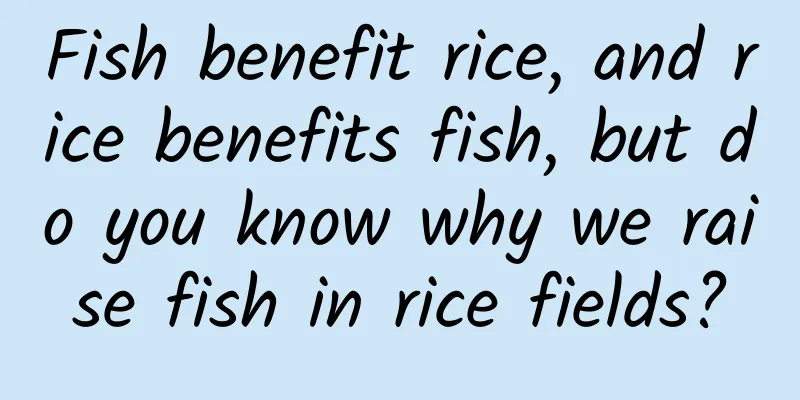Fish benefit rice, and rice benefits fish, but do you know why we raise fish in rice fields?

|
Where do fish live in nature? Streams, rivers, lakes, ponds, and oceans... fish can be found in many places with water. There is also a lot of water in rice fields. Can fish live in rice fields? Of course you can. As early as more than 2,000 years ago, hardworking and intelligent Chinese farmers began to raise fish in rice fields. First of all, fish living in rice fields do not have to worry about food. Rice fields not only have aquatic plants such as duckweed and water plants, but also many plankton and some insects that can harm rice. For fish, these are all natural food. By eating them, they can eat less or no artificial feed. For rice, fish are like dedicated bodyguards, helping to deal with pests and water plants that steal nutrients. In addition, the feces discharged by the fish can provide nutrients for the rice. They swim around in the rice fields, stirring up the muddy water and soil, making it easier for the roots of the rice to get oxygen. Of course, the fish in the rice fields will also be "rewarded". The thriving rice will provide them with a "green umbrella" to protect them from the sun. The fish that grow up in such a comfortable natural environment will be stronger and more delicious. Although fish living in rice fields are very comfortable, not all fish can make their home in rice fields. So, what kind of fish are suitable for living in rice fields? First, they must be suitable for living in shallow water environments, because the water depth of general rice fields is only about 20 cm; second, they must be herbivorous or omnivorous fish, because the food that rice fields can provide to fish is only some aquatic plants, plankton and insects. There are not many types of such fish. At present, the fish farmed in rice fields are mainly grass carp (black carp) and crucian carp. Image source: Pixabay Raising fish in rice fields seems to have many benefits, so are all rice fields suitable for raising fish? No. A rice field suitable for raising fish must meet at least two conditions: one is that there must be sufficient water to ensure that the rice field is constantly hydrated and does not dry up; the other is that the water in the field must be fluid and cannot remain stagnant. In my country, Qingtian, Zhejiang Province is one of the most successful places for rice-fish farming. Rice-fish farming has been around since the 9th century. At first, farmers used stream water to irrigate rice fields, and some fish swam into the rice fields with the stream water and settled there. Rice and fish grew naturally, forming a natural rice-fish symbiotic system. Many farmers in Qingtian County are most familiar with the technique of raising fish in rice fields. Every March, they keep male and female fish in their breeding period in large barrels, immerse them in soft pine branches, and let the female fish lay eggs on the branches. After more than a month, many small fish fry, about 1 to 2 centimeters long, appeared in the bucket, and it was the time to plant rice seedlings. After planting the rice seedlings, the farmers moved the fish fry to the rice fields. When the rice is ripe, farmers drain the water from the fields, and you can see many fish wriggling in the mud. They harvest the rice first, then catch the fish, and can harvest 30 to 40 kilograms of fish per mu of land. In addition to using fish to entertain guests, they also make fresh fish into dried fish. These delicious dried fish are in great demand, and people from other places often come to buy them. "Fish benefits rice, and rice benefits fish." Fish farming in rice fields is a typical mutually beneficial agricultural ecosystem. Source: Chongqing Industry-University-Research Cooperation Promotion Association Review expert: Xu Minglu, researcher at Chongqing Academy of Agricultural Sciences Statement: Except for original content and special notes, some pictures are from the Internet. They are not for commercial purposes and are only used as popular science materials. The copyright belongs to the original authors. If there is any infringement, please contact us to delete them. |
<<: Are hazelnuts and acorns "relatives"? I only found out after eating them for so many years...
>>: With high-speed railways everywhere, why do we still need to dig canals?
Recommend
Waymo withdraws some of its allegations against Uber: 3 of 4 patent lawsuits withdrawn
Beijing time, July 10 morning news, even though Wa...
After ten years of hard work, BYD's Han, the world's safest, smart, and new energy flagship sedan, is now available
The arrival of Han will not only shake up the glo...
I seem to have been diagnosed with "back-to-school anxiety disorder". Can I take sick leave?
Review expert: Chen Mingxin, national second-leve...
Behind the 260 million yuan fine: How did Qvod become a rogue platform?
It seems impossible for Qvod to be reborn. It was...
Xiaohongshu operation and promotion, Xiaohongshu grass-growing strategy!
1 Xiaohongshu was founded on June 6, 2013. It was...
Guess lantern riddles during the Lantern Festival! Here’s a secret tip for guessing riddles…
Guessing lantern riddles is a fun activity during...
Yan Hu's Mandala Painting Theory + Practical Painting Psychology Video Course 26 Lectures on Emotional Regulation and Self-Growth
Yan Hu's Mandala Painting Theory + Practical ...
The "formula for becoming popular" summarized after 10 years of marketing experience, 99% of the hot spots became popular this way!
"Formula for going viral": creating sur...
Rare! A green sky appeared in this city!
Recently, the sky in Sioux Falls, South Dakota, U...
World's first! Gene-edited pig heart transplanted into human body
The University of Maryland School of Medicine iss...
90% of designers agree on these 7 design habits, but they may harm you
When many designers first start designing, they m...
When will Fuyang, Anhui be unsealed in 2022? When will the epidemic end? Attached the latest news
Recently, many areas in Anhui have also reported n...
Understanding the Infernal Affairs of Coolpad, 360, and LeTV
[[138273]] Coolpad Group announced that the compa...
How to improve the effectiveness of information flow advertising by making good use of pictures?
We all know that it is not easy to make a success...
Artificial Intelligence Report: Scaling
Accenture has released a new report, “Artificial ...









